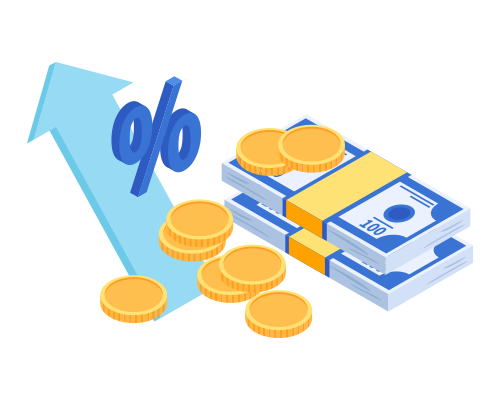What are Mutual Funds?
Mutual Funds (MF) is a mechanism to pool money from investors who wish to save and invest in securities through professional management to achieve one’s financial needs. When you invest in mutual funds, you purchase units that represent your ownership in the fund.
Mutual Funds are established as Trusts and are regulated by the Securities and Exchange Board of India (SEBI).
Benefits of Investing in Mutual Funds

Professionally Managed
Diversification of Investments
Mutual funds invest in a variety of securities across different asset classes. This helps reduce risk by reducing the losses that may happen in a single investment.


Affordable
Mutual funds allow investments with very low amounts, as little as ₹100 for some open-ended schemes. This makes it very easy to get started and get access to diversified portfolios.
Cost Efficiency


Tax Benefits
Mutual funds under the ELSS schemes offer tax benefits under section 80C of the Income Tax Act for up to ₹1.5 lakhs per annum. Further, the long-term gains on Equity mutual funds are taxed lower
Regulated
Mutual funds are regulated by the Securities and Exchange Board of India (SEBI) which enforces high standards of transparency and investor protection.

Types of Mutual Funds
- Equity Mutual Funds
- Debt Mutual Funds
- Hybrid Mutual Funds
- Liquid Fund Data
- BALANCED FUNDS
- Exchange Traded Funds (ETFs)
An equity fund is a mutual fund scheme that invests predominantly in equity stocks.
In the Indian context, as per current SEBI Mutual Fund Regulations, an equity mutual fund scheme must invest at least 65% of the scheme’s assets in equities and equity related instruments.
An Equity Fund can be actively managed or passively managed. Index funds and ETFs are passively managed.
Equity mutual funds are principally categorized according to company size, the investment style of the holdings in the portfolio and geography.
The size of an equity fund is determined by a market capitalization, while the investment style, reflected in the fund's stock holdings, is also used to categorize equity mutual funds.
Equity funds are also categorized by whether they are domestic (investing in stocks of only Indian companies) or international (investing in stocks of overseas companies). These can be broad market, regional or single-country funds.
Some specialty equity funds target business sectors, such as health care, commodities and real estate and are known as Sectoral Funds.
DIFFERENT CATEGORIES OF EQUITY FUNDS:
There are different types of equity mutual fund schemes and each offers a different type of underlying portfolio that have different levels of market risk.
Large Cap Equity Funds: invest a large portion of their corpus in companies with large market capitalization are called large-cap funds. This type of fund is known to offer stability and sustainable returns, over a period of time.
Large Cap companies are generally very stable and dominate their industry. Large-cap stocks tend to hold up better in recessions, but they also tend to underperform small-cap stocks when the economy emerges from a recession. Large-cap tend to be less volatile than mid-cap and small-cap stocks and are therefore considered less risky.
Mid-Cap Equity Funds: Invest in stocks of mid-size companies, which are still considered developing companies. Mid-cap stocks tend to be riskier than large-cap stocks but less risky than small-cap stocks. Mid-cap stocks, however, tend to offer more growth poten.
Small Cap Funds: Invest in stocks of smaller-sized companies. Small cap is a term used to classify companies with a relatively small market capitalization. However, the definition of small cap can vary among market intermediaries, but it is generally regarded as a company with a market capitalization of less than ₹ 100 crores. Many small caps are young companies with significant growth potential. However, the risk of failure is greater with small-cap stocks than with large-cap and mid-cap stocks. As a result, small-cap stocks tend to be the more volatile (and therefore riskier) than large-cap and mid-cap stocks. Historically, small-cap stocks have typically underperformed large-cap stocks during recessions but have outperformed large-cap stocks as the economy has emerged from recessions.
The smallest stocks of the small caps are called micro-cap stocks. While the opportunity for these companies to experience extreme growth is great, the risk to lose a large amount of money is also possible
Multi Cap Equity Funds or Diversified Equity Funds: Invests in stocks of companies across the stock market regardless of size and sector. These funds provide the benefit of diversification by investing in companies spread across sectors and market capitalisation. They are generally meant for investors who seek exposure across the market and do not want to be restricted to any particular sector. They invest in companies across different market caps and hence reduce the amount of risk in the fund. Diversification helps prevent events that could affect a single sector for affecting the fund, and hence reduce risk.
Thematic Equity Funds: These funds invest in securities of specific sectors such as Information Technology, Banking, Service and pharma sector etc., which is specified in their scheme information documents. So, the performance of these schemes depends on the performance of the respective sector. These funds may give higher returns, but they also come with increased risks.
EQUITY LINKED SAVINGS SCHEME (ELSS):
Equity-Linked Savings Scheme (ELSS) is an equity mutual fund investment that invests at least 80 per cent of its assets in equity and equity-related instruments. ELSS can be open-ended or close ended. Investments in an ELSS qualify for tax deductions under Section 80C of the Income Tax Act within the overall limit of ₹1.5 lakh. The amount you invest in ELSS is deducted from your taxable income, which helps you lower the amount of income tax you are liable to pay. Investments in ELSS are subject to a three-year lock-in period.
WHAT IS DEBT FUND?
A debt fund is a mutual fund scheme that invests in fixed income instruments, such as Corporate and Government Bonds, corporate debt securities, and money market instruments etc. that offer capital appreciation. Debt funds are also referred to as Income Funds or Bond Funds.
HOW DEBT FUNDS ARE DIFFERENT FROM OTHER MUTUAL FUND SCHEMES?
In terms of operation, debt funds are not entirely different from other mutual fund schemes. However, in terms of safety, they score higher than equity mutual funds. For instance, when the market falls, the NAVs of your equity funds fall sharply, whereas in case of debt funds, the fall is not as sharp. Having said that, debt funds can offer only moderate returns, while equity funds, which are highly risky, offer high returns over longer time horizon.
HOW DEBT FUNDS WORK?
Debt funds invest in either listed or unlisted debt instruments, such as Corporate and Government Bonds at a certain price and later sell them at a margin. The difference between the cost and sale price accounts for the appreciation or depreciation in the fund’s net asset value (NAV). Debt funds also receive periodic interest from the underlying debt instruments in which they invest. In terms of return, debt funds that earn regular interest from the fixed income instruments during the fund’s tenure are similar to bank fixed deposits that earn interest. This interest income gets added to a debt fund on a daily basis. If the interest payment is received, say, once every year, it is divided by 365 and the debt fund’s NAV goes up daily by this small amount. Thus, a debt scheme’s NAV also depends on the interest rates of its underlying assets and also on any upgrade or downgrade in the credit rating of its holdings.
Market prices of debt securities change with movements in interest rates. Let’s assume, your debt fund owns a security that yields 10 % interest. If the interest rate in the economy falls, new instruments issued in the market would offer this lower rate. To match this lower rate, there would be an increase in the prices your fund’s underlying instruments as they have a higher coupon (interest) rate. As a result of the increase in the debt instrument’s value, your fund’s NAV, too, would increase.
Invest in both equity and debt in varying proportions depending on the investment objective of the fund. Thus, hybrid funds give you diversified exposure to various asset classes. Hybrid funds are categorized on the basis of their allocation to equity and debt.
Liquid Funds, as the name suggests, invest predominantly in highly liquid money market instruments and debt securities of very short tenure and hence provide high liquidity. They invest in very short-term instruments such as Treasury Bills (T-bills), Commercial Paper (CP), Certificates Of Deposit (CD) and Collateralized Lending & Borrowing Obligations (CBLO) that have residual maturities of up to 91 days to generate optimal returns while maintaining safety and high liquidity. Redemption requests in these Liquid funds are processed within one working (T+1) day.
The aim of the fund manager of a Liquid Fund is to invest only into liquid investments with good credit rating with very low possibility of a default. The returns typically take the back seat as protection of capital remains of utmost importance. Control over expenses in the form of low expense ratio, good overall credit quality of the portfolio and a disciplined approach to investing are some of the key ingredients of a good liquid fund.
Most retail customers prefer to keep their surplus cash in Savings Bank deposits as they consider the same to be safest and they could withdraw the money at any time. Liquid Funds and Money Market Mutual Funds provide a more attractive option. Surplus cash invested in money market mutual funds earns higher post-tax returns with a reasonable degree of safety of the principal invested and liquidity.
Liquid funds are preferred by investors to park their money for short periods of time typically 1 day to 3 months. Wealth managers suggest liquid funds as an ideal parking ground when you have a sudden influx of cash, which could be a huge bonus, sale of real estate and so on and you are undecided about where to deploy that money. Investors looking out for opportunities in equities and long-term fixed income instruments can also park their money in the liquid funds in the meantime. Many equity investors use liquid funds to stagger their investments into equity mutual funds using the Systematic Transfer Plan (STP), as they believe this method could yield higher returns.
A balanced fund combines equity stock component, a bond component and sometimes a money market component in a single portfolio. Generally, these hybrid funds stick to a relatively fixed mix of stocks and bonds that reflects either a moderate, or higher equity, component, or conservative, or higher fixed-income, component orientation.
These funds invest in a mix of equities and debt, giving the investor the best of both worlds. Balanced funds gain from a healthy dose of equities but the debt portion fortifies them against any downturn.
Balanced funds are suitable for a medium-term horizon and are ideal for investors who are looking for a mixture of safety, income and modest capital appreciation. The amounts this type of mutual fund invests into each asset class usually must remain within a set minimum and maximum.
Although they are in the "asset allocation" family, balanced fund portfolios do not materially change their asset mix. This is unlike life-cycle, target-date and actively managed asset-allocation funds, which make changes in response to an investor's changing risk-return appetite and age or overall investment market conditions.
EQUITIES AND INFLATION:
Investors who have dual investment objectives favour Balanced Funds. Typically, retirees or investors with low risk tolerance prefer these funds for growth that outpaces inflation and income that supplements current needs. While retirees generally scale back risk as age advances, many individuals recognize the need for equity exposure as life expectancies increase. Equities prevent erosion of purchasing power and help ensure long-term preservation of retirement corpus.
INCOME NEEDS:
The bond component of a balanced fund serves two purposes: creating an income stream and moderating portfolio volatility. Investment-grade bonds such as AAA corporate bonds and Money market instruments interest income from periodic payments, while large-company stocks offer dividend payouts to enhance yield. Retired investors may take distributions in cash to bolster income from pensions and personal savings.
Secondarily, bonds hold much less volatility than stocks. Bondholders have a claim against assets of a company while stocks represent ownership, bearing all inherent risk if bankruptcy occurs. Hence, debt security prices do not move in lockstep with equities, and their stability prevents wild swings in the share price of a balanced fund.
An ETF, or exchange traded fund, is a marketable security that tracks an index, a commodity, bonds, or a basket of assets like an index fund.
In the simple terms, ETFs are funds that track indexes such as CNX Nifty or BSE Sensex, etc. When you buy shares/units of an ETF, you are buying shares/units of a portfolio that tracks the yield and return of its native index. The main difference between ETFs and other types of index funds is that ETFs don't try to outperform their corresponding index, but simply replicate the performance of the Index. They don't try to beat the market, they try to be the market.
Unlike regular mutual funds, an ETF trades like a common stock on a stock exchange. The traded price of an ETF changes throughout the day like any other stock, as it is bought and sold on the stock exchange. The trading value of an ETF is based on the net asset value of the underlying stocks that an ETF represents. ETFs typically have higher daily liquidity and lower fees than mutual fund schemes, making them an attractive alternative for individual investors.
Passive Management:
ETFs are passively managed. The purpose of an ETF is to match a particular market index, leading to a fund management style known as passive management. Passive management is the chief distinguishing feature of ETFs, and it brings a number of advantages for investors in index funds. Essentially, passive management means the fund manager makes only minor, periodic adjustments to keep the fund in line with its index. An investor in an ETF do not want fund managers to manage their money i.e., decide which stocks to buy/sell/ hold), but simply want the returns to mimic those from the benchmark index. Since buying all scrips that are part of say, the Nifty (which has 50 scrips) is not possible, one could invest in an ETF that tracks Nifty.
This is quite different from an actively managed fund, like most mutual funds, where the fund manager ‘actively’ manages the fund and continually trades assets in an effort to outperform the market.
Because they are tied to a particular index, ETFs tend to cover a discrete number of stocks, as opposed to a mutual fund whose scope of investment is subject to continual change. For these reasons, ETFs mitigate the element of "managerial risk" that can make choosing the right fund difficult. Rather than investing in an ‘active’ fund managed by a fund manager, when you buy shares of an ETF you're harnessing the power of the market itself.
ETFs are cost-efficient:
Because an ETF tracks an index without trying to outperform it, it incurs lower administrative costs than actively managed portfolios. Typical ETF administrative costs are lower than an actively managed fund, coming in less than 0.20% per annum, as opposed to the over 1% yearly cost of some actively managed mutual fund schemes. Because they have lower expense ratio, there are fewer recurring costs to diminish ETF returns.
GOLD ETF:
A Gold ETF is an exchange-traded fund (ETF) that aims to track the domestic physical gold price. They are passive investment instruments that are based on gold prices and invest in gold bullion.
In short, Gold ETFs are units representing physical gold which may be in paper or dematerialised form. One Gold ETF unit is equal to 1 gram of gold and is backed by physical gold of very high purity. Gold ETFs combine the flexibility of stock investment and the simplicity of gold investments.
In short, Gold ETFs are units representing physical gold which may be in paper or dematerialised form. One Gold ETF unit is equal to 1 gram of gold and is backed by physical gold of very high purity. Gold ETFs combine the flexibility of stock investment and the simplicity of gold investments.
Gold ETFs are listed and traded on the National Stock Exchange of India (NSE) and Bombay Stock Exchange Ltd. (BSE) like a stock of any company. Gold ETFs trade on the cash segment of BSE & NSE, like any other company stock, and can be bought and sold continuously at market prices.
Buying Gold ETFs means you are purchasing gold in an electronic form. You can buy and sell gold ETFs just as you would trade in stocks. When you actually redeem Gold ETF, you don’t get physical gold, but receive the cash equivalent. Trading of gold ETFs takes place through a dematerialised account (Demat) and a broker, which makes it an extremely convenient way of electronically investing in gold.
Because of its direct gold pricing, there is a complete transparency on the holdings of a Gold ETF. Further due to its unique structure and creation mechanism, the ETFs have much lower expenses as compared to physical gold investments.
EQUITIES AND INFLATION:
Investors who have dual investment objectives favour Balanced Funds. Typically, retirees or investors with low risk tolerance prefer these funds for growth that outpaces inflation and income that supplements current needs. While retirees generally scale back risk as age advances, many individuals recognize the need for equity exposure as life expectancies increase. Equities prevent erosion of purchasing power and help ensure long-term preservation of retirement corpus.
INCOME NEEDS:
The bond component of a balanced fund serves two purposes: creating an income stream and moderating portfolio volatility. Investment-grade bonds such as AAA corporate bonds and Money market instruments interest income from periodic payments, while large-company stocks offer dividend payouts to enhance yield. Retired investors may take distributions in cash to bolster income from pensions and personal savings.
Secondarily, bonds hold much less volatility than stocks. Bondholders have a claim against assets of a company while stocks represent ownership, bearing all inherent risk if bankruptcy occurs. Hence, debt security prices do not move in lockstep with equities, and their stability prevents wild swings in the share price of a balanced fund.
Why Mutual Funds ?
Real Return = Return on Investment (%) – Inflation (%)
To invest in a scheme where one gets 8% return on the investment. Now, if we consider 6% inflation, the real rate of return would be only 2% (8% - 6% inflation). Is it enough to achieve our various goals in life?
Value Averaging (Invest in ups & downs)
No one knows whether any given time is the right time to buy or sell? A more successful strategy is 'Rupee Cost Averaging' wherein one invests a fixed amount regularly (preferably monthly). Thus, we purchase more when the prices are low, and purchase less when the prices are high.
Power of compounding
For Instance: We are investing Rs. 10,000 per month in Postal Scheme for 30 years. We will get Rs. 1.5 Cr at the rate of 8% whereas Mutual Fund Equity scheme can give us the return of Rs. 23 Cr (calculated at 15% CAGR).
Ways / Modes of Mutual Funds
Investment

Lumpsum Investment: One Time Investment
A "lumpsum investment" refers to a one-time, single payment made upfront to invest a significant amount of money in an asset like a mutual fund, fixed deposit, or other investment vehicle.

SIP: Systematic Investment Plan
A Systematic Investment Plan (SIP) is an investment tool which allows the investor to invest a fixed amount at regular intervals in a Mutual Fund scheme.


